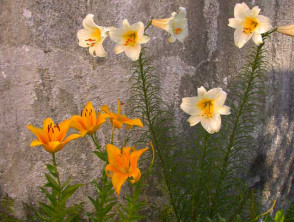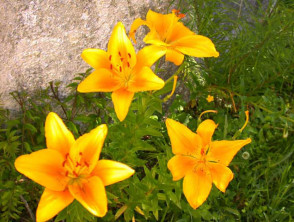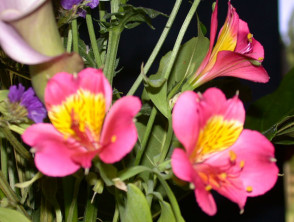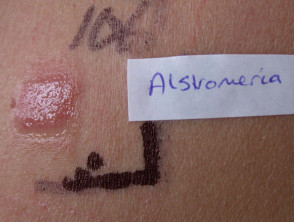| Common name: | Peruvian lily, Lily of the Incas, St Martin's Flower |
| Botanical name: | Alstroemeria |
| Family: | Amaryllidaceae or lily family. This very large family contains about 3,700 species in 250 genera, is as a whole cosmopolitan, but certain groups are of limited distribution. Some authors regard Alstroemeriaceae as a distinct family of 4 genera and about 150 species. |
| Origin: | South America, particularly Chile and Peru. |
| Description: | A herbaceous perennial with fleshy, tuberous roots. They have twisted lanceolate leaves, irregularly trumpet-shaped flowers which are born on slender leafy stems. |
| Uses: | Floral bouquets/ornamental cut flowers. |
| Allergens: | Tuliposide A, the biosynthetic precursor of the allergenic lactone tulipalin A, has been detected in many species of Alstroemeria and Bomarea Mirb. Alpha-methylene-gamma-butyrolactone. |
| Allergy: | Fingertip allergic contact dermatitis is caused by contact with recently damaged plants and bulbs, and gives rise to a condition known as tulip fingers. The first case reports of allergic contact dermatitis produced by Alstroemeria species appeared early in the 1970s. Gardeners, florists, and housewives are at most risk. Typically, patients are florists who present with red, thickened and split, tender finger tips of both hands Airborne contact dermatitis has also been reported. This may reflect sesquiterpene lactone sensitivity. More unusually, alstroemeria has been observed to cause depigmentation. A florist developed a sense of throat tightness, allergic rhinoconjunctivitis, urticaria, and facial angioedema attributable to exposure to alstroemeria. For most patients, the allergy leads to a change of profession. |
| Cross reactions: | Bomarea, Dioscorea hispida, Erythronium, Gagea, Fritillaria, and at least one species of onion. |
| Other information: | Wear nitrile gloves. |
| Patch test: | Plants ‘as is’, Tulipalin A, Alpha-methylene-gamma-butyrolactone, sesquiterpene lactones. |



